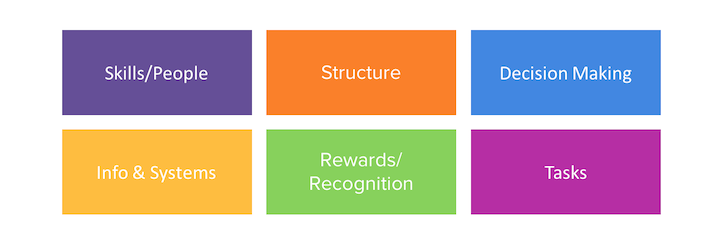How to Transform Into a Customer-Centric Merchandise Planning Organization
In our last Blog post – Making the Case for a Customer-Centric Transformation in Merchandise Planning - we discussed “why” your organization should embrace customer-centric thinking in planning. In this post, we will layout “how” your organization can make this shift.
The most important thing that everyone within your organization must understand and embrace when mapping out the path to customer-centricity is that it is a multi-dimensional journey. This transformation does not happen overnight, and is truly on-going as the company continues to grow and new strategies are created that must also be customer-centric.
According to retail industry expert Sonia Parekh, Senior Manager at Kalypso, there are six key areas that are necessary to focus on in order to make your organization truly customer-centric – decision making, tasks, organizational structure, skills/people, rewards/recognition and information & systems. In this post, we will break down each area and go through the questions you need to answer as you take your organization through this transformation.

1. Decision-Making
It is crucial you start this journey by taking a look at your merchandising and merchandise planning processes from end to end, and identify the critical points at which the entire team must align and lock down certain decisions in order to move forward. This includes the selection and pricing of the assortment. Typically, these decisions are approached with information about what sold last year, what categories or subcategories are trending and how we need to plan brands to achieve external incentives provided by vendors (like volume discounts, promotional support, etc.).
A customer-centric merchandising group acts very differently. They put the customer first in every decision. Think about your various customer segments and how each responds to different silhouettes, colors, brands, materials, etc. Once this is done, select an assortment that best meets the needs and preferences of your customer.
Also, think about what prices will maximize demand for each customer segment. For example, if you are planning the baby diaper category, you are likely to have a price-driven customer segment – one that wants a diaper that they trust at the lowest price possible. They will have a price ceiling that is lower than the customer segment who will pay more for a diaper that has fun designs or is made of biodegradable materials.
So that leads us to the next question – how do your customers value different brands, materials and product features? For example, how do moms in the Pacific Northwest make decisions around the boots they purchase for their kids? How do these crucial purchase criteria differ from moms in the Midwest or Southeast? Customer-centric merchants and planners take all of this into consideration when making merchandising decisions.
2. Tasks
As you change the way decision-making is done, you must also change the actual activities and tasks along with the sequence in which they are performed and perhaps even the organization or team responsible for each one. In a customer-centric merchandising world, you will be developing assortments, considering pricing strategies, planning promotions and allocating product by customer segment. You must ask yourself: how does the work get done today? What does the process look like? If your key decisions change, in what ways may the process need to change?
Start by taking each key decision and define what work needs to get done leading up to that decision. What information do you need to gather, what analysis do you need to do, etc.? How should the work be sequenced? Who needs to own each step? Use the key decisions as your anchor points and chart the course to get from one to the next. This course will become your new process.
3. Organizational Structure
Changes to the structure of your organization will most likely be required in order to enable and reinforce these new processes. This organizational transformation needs to be supported by a robust change management program that includes understanding of your current state, drafting a vision for the future and then putting in place a transformation roadmap with all the training, development and communication necessary to get you there. In the end, you need to be able to confidently answer “yes” to the question - “Does my organization enable the right people to get the job done?”
4. Skills/People
Thinking about decisions from a customer-centric perspective while creating your optimal organizational structure requires your current team to not only change the way they work, but also build some totally new skills. Start by benchmarking where your people are today. This includes determining what skillsets you currently have in your merchandising and planning group, and then identifying what new skills they need in order to operate in the customer-centric world.
You will also need to do a workload analysis to determine if you have the right headcount in the right places. There will potentially be a need for people to transition from one role to another. This will mean identifying who has the raw capability to make that change and then supporting them through that transition. Once this is complete, build a plan for training and development. Finally, determine if you need to hire additional people who bring customer-centric thinking and can help lead the change.
Lastly, you need lots of communication. Organizational change can cause lots of swirl which impacts productivity and can impact people’s willingness to change. Having a well thought-out communication plan to make sure everyone understands the reason for the change and what the journey looks like is imperative. Don’t leave room for guessing and anxiety.
5. Rewards & Recognition
Once you have the organizational structure and people in place, you can then focus on aligning your processes to include rewards and recognition for customer-centric behavior. Incentives are vital to making long-term changes. At the same time, you want your people to be accountable for the business impact of the change, so best practice is to start by including metrics which tie the customer impact to the business results.
Merchants and planners are very familiar with being held accountable for sales and profitability, but you will need to add things like customer engagement, basket size, shopping frequency and return rates, among others. You can see how movement in customer metrics directly impacts sales and profits, but without holding the team accountable for the customer metrics, they won’t have an incentive to make it their primary focus.
Finally, you should track all customer metrics and report them on a regular basis, making it a point to show everyone in the company that these new metrics are just as important as the typical sales and profit metrics that they are accustomed to seeing.
6. Information & Systems
Information and the systems we use to gather and analyze it are the backbone of a customer-centric organization. They enable all of the planning processes to work accurately and efficiently. In a customer-centric merchandising organization, customer information is gathered on an ongoing basis and analyzed to better understand customer preferences and even to predict their behavior. We have multiple sources of customer information, but the key is to find a way to make it actionable.
In order to truly transform into a customer-centric planning organization, you need to have the right systems in place to capture and analyze data and enable the end-to-end planning process. When looking for a system that will enable a true customer-centric planning organization and process, here are some key considerations and features to look for.
- Predict and Plan for Trends. Your system needs to be able to track and maintain customer data and use that data to segment customers and identify, predict and plan for trends.
- Multi-dimensional Clustering. It's not possible to think about every possible customer. You need a system that can cluster customers using attributes derived from the analysis of customer information. However, in addition to customer attributes you need to consider location attributes. The only way to truly do this is through multi-dimensional clustering across many attributes.
- Define Assortments Around Clusters. Once you have your clusters defined, you need a system that can define assortments within those clusters taking into account the customers that are drawn to those clusters and the demand they are driving.
- Combine Analytical Planning with Visualization. Part of a planner’s job is subjective and requires being able to visualize what the assortment will look like. But this needs to be coupled with analytical planning to determine how customers are expected to respond to the assortment and its related pricing and promotions.
- Attribute-based Planning. Understanding what is driving a trend requires analyzing many attributes. So you need a system that can record as many attributes as possible and attribute them to a low level of detail in order to truly identify what attributes are driving what customer trends.
- Omni-channel Line Planning. You need a system that can plan the entire line across different channels, taking into account the uniqueness of customer-centric trends that are driving the performance of products within each channel.
- Allocate in Line with the Assortment Plan. The success of a great assortment plan depends on the inventory being allocated in line with the plan. Your assortment and allocation systems need to be tightly integrated to ensure that the customer-driven assortments are actually delivered to the customers who are going to shop them.
- Retrend in Season. Nothing ever stays the same, so you need a system that can very quickly identify emerging and changing product trends. The system should automatically retrend and change direction based on analytical analysis. But if the change is too vast, the system should present exceptions to planners so they can make strategic decisions on whether or how to follow a trend.
Time to Get Started
Now that you understand the need for becoming customer-centric in your merchandise planning and have the framework for making the transformation, it's time to get started. We encourage you to partner with the right industry and business process experts and technology vendors who understand your company's specific needs and business strategies and can help you make the shift to truly customer-centric merchandising.
See article on JustEnough's blog
Guest Experts
Sahir Anand, VP of Research and Principle Analyst, EKN
Peter Leith, VP of Product Strategy, JustEnough

